Time Speciale 10 and Speciale 12 Pedals
Test Locations: Montana, Washington
Test Duration: 2 Months
Blister’s Measured Weights:
- Speciale 10 Small: 198 g / pedal
- Speciale 10 Large: 204 g / pedal
- Speciale 12 Large: 178 g / pedal
MSRP:
- Speciale 10: $180
- Speciale 12: $350
Bolted To: Norco Range, Transition Sentinel, Trek Top Fuel, Deviate Highlander II
Reviewers:
- Noah Bodman: 5’9”, 160 lbs / 175 cm, 72.5 kg
- David Golay: 6’, 170 lb / 183 cm, 77.1 kg
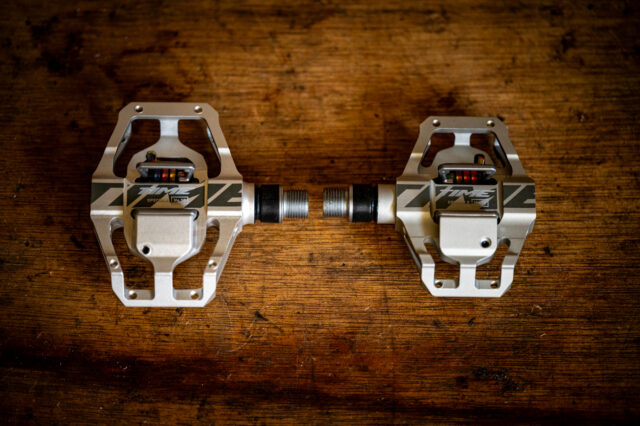
Intro
Noah Bodman: In 2021, SRAM bought Time Sport, the makers of the long-running line of pedals based around the ATAC design. For those like myself who have been running Time pedals for decades, this brought about many restless nights, tossing and turning while contemplating the fate of our favorite pedals.
Would SRAM use its position as a bike component juggernaut to improve on a timeless(!) design? Or would they fail to leave it well enough alone and screw up a good thing?
This spring, SRAM announced an update to the Time pedal line and I’ve since been testing a few pairs. So, can I and other fans of the prior pedals finally sleep easy again?
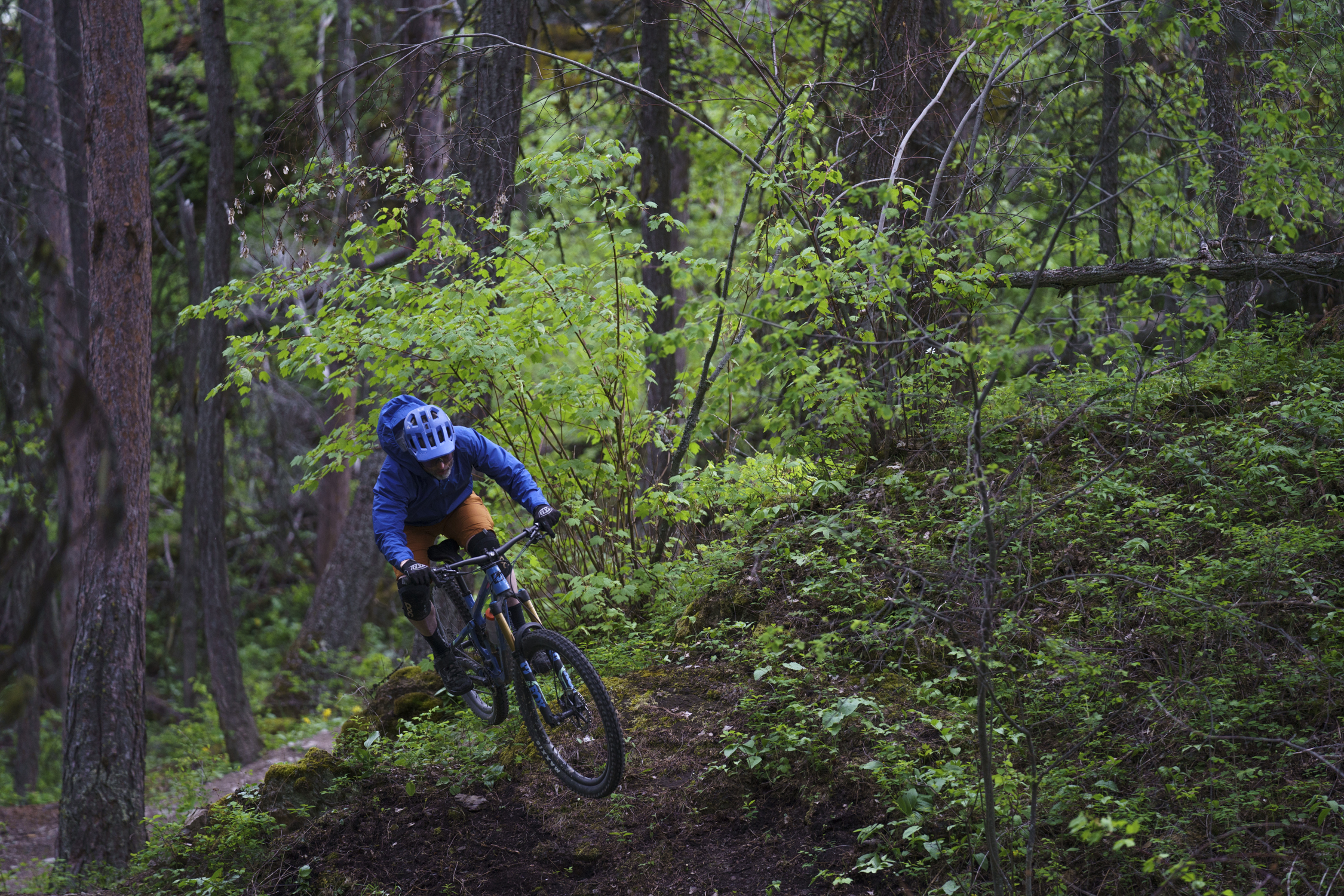
The Updates
In large part, the updates to the Time lineup are in name only. The prior versions of the Time Trail-oriented pedal were the Speciale 8 and the Speciale 12, with the 12 being larger, nominally lighter, and considerably more expensive due to its titanium axle.
The new versions of the Speciale series get a minor re-naming and some additional options. Gone is the Speciale 8, now replaced by the Speciale 10 (MSRP: $180). The Speciale 12 remains, still with a titanium axle, and still considerably more expensive (MSRP: $350). The biggest change is that both the 10 and 12 are available with either a small or large platform. The 10 is also available in a small assortment of colors (gray, raw aluminum, purple, and orange), while the 12 is only available in black (with gold accents).
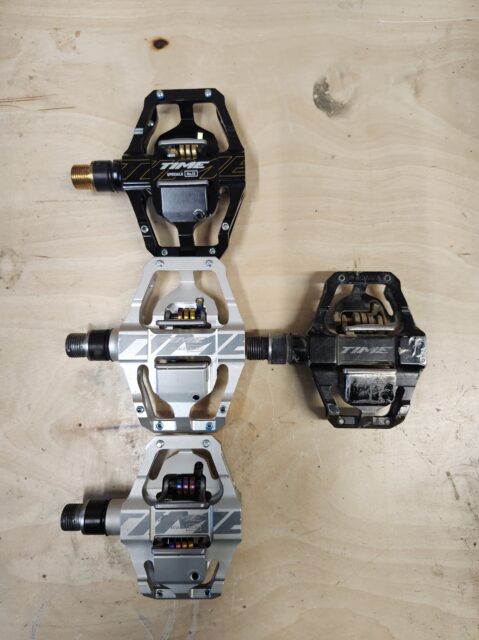
Time also applied some similarly minor updates to their ATAC XC lineup. They now offer the XC 6 (steel spindle, composite body), the XC 10 (hollow steel spindle, carbon body), and the XC 12 (titanium spindle, carbon body). Functionally, these pedals are identical to the Speciale lineup, just without the pedal platform surrounding the ATAC clip mechanism.
[For a more detailed rundown on the whole lineup, check out our First Look from back in the spring; from here on out, we’re going to focus on the Speciale 10 and 12 that we’ve been testing.]
Functionality and Details
Aside from offering some different platform sizes and different colors, the new Speciale 10 and 12 are essentially identical to the prior versions (the Speciale 8 and 12, respectively), which had been in the Time lineup for roughly five years.
They spin on one steel-ball cartridge bearing on the outboard side of the pedal and a bushing on the inboard side. I’ve been running Speciale 8’s since they came out in 2019 and have never had to replace a bearing or bushing, so I expect the new versions to be long-lived as well.
All of Time’s mountain bike pedals are built around the same ATAC system, which uses a spring-loaded toe bail and a fixed heel bail. The spring tension on the toe bail can be adjusted on all versions of the Speciale pedals, and I find that the range of tension is significant — personally, I end up somewhere at the lighter end of the middle of the range.
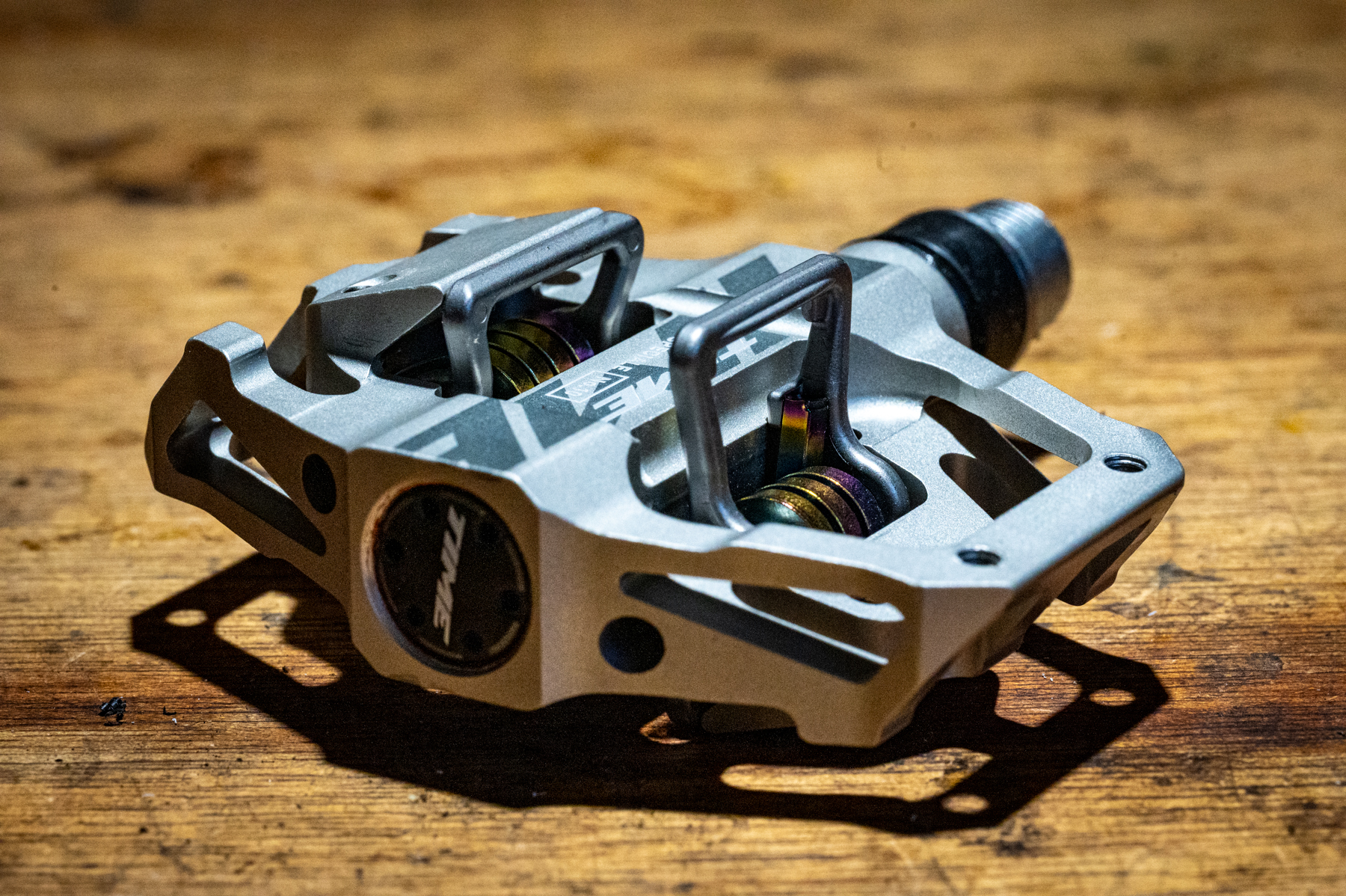
The Time cleats can be swapped between feet; in one orientation, they’ll provide a release angle of 13°, and swapped to the other foot, they’ll provide a 17° release. Time also offers an “Easy” version of their cleats with a 10° release angle. The standard cleats allow for a stated 5° of free float before the cleat starts engaging the bail (but again, it will need to rotate 13° or 17° before it releases). The cleats allow for ±2.5 mm of side-to-side movement, although in practice I find that it takes a conscious effort to wiggle my foot over once clipped in, and this is often limited by the shoe contacting some part of the pedal.
All versions of the Speciale pedals have removable / replaceable pedal pins, but the Large versions have 4 more pins (2 per side) than the Small versions.
On the Trail
Noah Bodman: As I mentioned above, I’ve been on Time pedals since sometime in the early 2000’s, so this is partly a review of the new Speciale 10 and 12, and partly a review of Time pedals in general.
David Golay: I, on the other hand, last rode a Time pedal right around when Noah started using them, so I was curious to give them a try again. I only spent a few rides on the Large Speciale 10s before handing them off to Noah, our resident Time aficionado, so I’ll leave all the stuff about longer-term durability and the like to him. But I’ll chime in a bit on their feel and how that compares to other options on the market.
Noah: For my tastes, the new Time pedals are great, mostly because they’re relatively unchanged. The large version of the Speciale 10 is my personal pick — I like the bigger platform because it’s a bit easier to stand on while not clipped in. Of course, I’m (theoretically) always clipped in while riding, but shit happens and sometimes I can’t get my foot back in through some janky weirdness, so I ride it like a platform pedal.
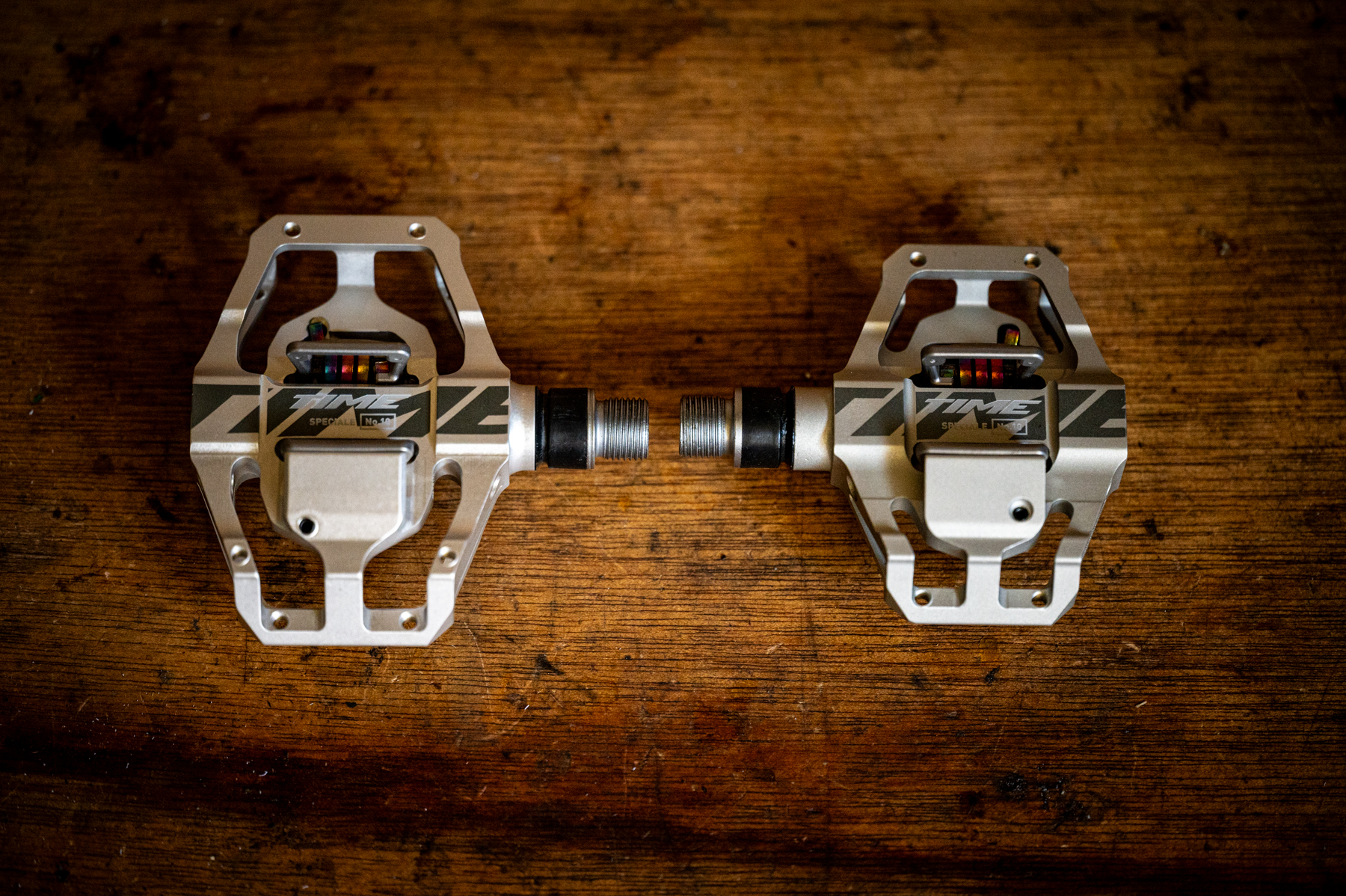
The bigger platform and the extra couple of screws make that a less sketchy scenario than on the smaller version of the pedal. And given that the weight penalty is pretty minor, there’s not a huge downside to the bigger version. The Speciale 12 is fantastic, but the nominal reduction in weight isn’t really worth the cost in my eyes, and I’ve never had durability issues with the steel spindles so I don’t see a pressing need for titanium.
So, why Time pedals in a more general sense? Personally, it’s mostly because of the high release angle. I always run my cleats in the 17° release position because I don’t want to come out of my pedals unintentionally. And with Times, I come out unintentionally very, very rarely. I also find the release to be very consistent, so when I do need to get out of my pedal in a hurry, it generally happens without any sketchy hang-ups.
Along those lines, clipping a pedal on a rock or the ground generally doesn’t lead to a release, unlike, for example, a Crankbrothers pedal. The leading edge of the Speciale pedals is also shaped in a way that tends to slip over rocks without too much fuss (or damage to the pedal). I also find that Times clear mud well — it’s rare that they gum up enough to interfere with clipping in and out.
David: I don’t disagree with any of the ways that Noah has characterized the Speciale-series pedals, but I’ve got different preferences for different reasons. We’ll go deeper on some comparisons to other pedal systems in a moment, but I find the Speciale pedals to feel looser and floatier than I’d prefer.
I didn’t have any issues with inadvertently clipping out of them, even with relatively moderate tension settings in the default 17° release angle. Still, even with relatively gravity-oriented shoes with big, flat outsoles (I tried Crank Brothers Mallet Boas and Specialized 2FO DHs), there’s a bit of extra clearance between the pedal body and the sole of the shoe. You can get them to make contact with each other, but it takes a bit of tipping the shoe side to side to close the gap down, and the result is just a slightly less direct-feeling connection to the pedal than I’d prefer.
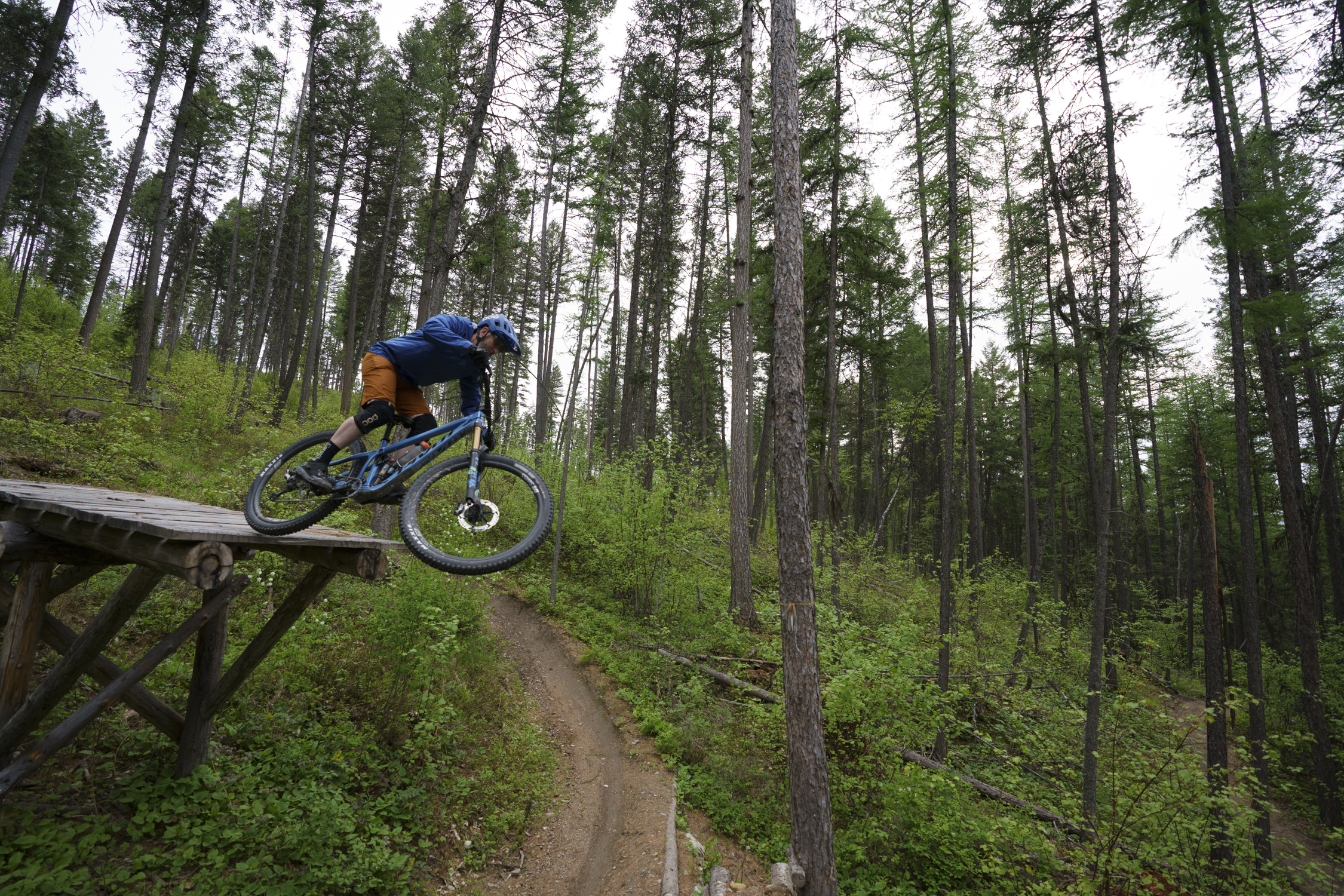
On the plus side, I give the Speciale 10s high marks for still adequately keeping my feet in while being notably easy to clip into and out of when I want to. The clipping-in motion feels subtly different from a lot of other pedals, I think because the movable portion of the clip mechanism is at the toe rather than the heel. But after a brief adjustment period, I found them super easy to get into.
Noah: Last but definitely not least, I find Time pedals to be very durable. I have multiple pairs of Speciale 8s that are 4-5 years old. They’ve seen thousands of miles, they’ve been run on everything from hardtails to DH bikes, they’ve been smashed into rocks, ridden through rivers, and generally abused — but they’re still going strong.
Of course, nothing is perfect, and there are two issues I’ve found with Time pedals. First, after many miles, I sometimes get a little creak out of the pedals. Some lube on the bail springs solves this. Second, I’m finding that some new shoes don’t play well with Time pedals.
Time pedals work best with a shoe that has a cleat cavity that lightly contacts the rear of the pedal. Because the movable part of the clip mechanism is in the toe, pushing forward on the shoe with a lot of force can open that bail. For normal pedaling, this isn’t an issue, but during hard compression and when landing jumps, I can feel the shoe push the bail forward, which is a bit disconcerting.
This only happens in shoes with a very open cleat recess; on more traditional models, the shoe contacts the pedal and prevents the shoe from rocking the bail forward. Unfortunately, a lot of shoe companies have started opening up the back of their cleat recess, so while this is probably good for clearing mud, it has effectively limited the shoes that I’ll run with Time pedals.
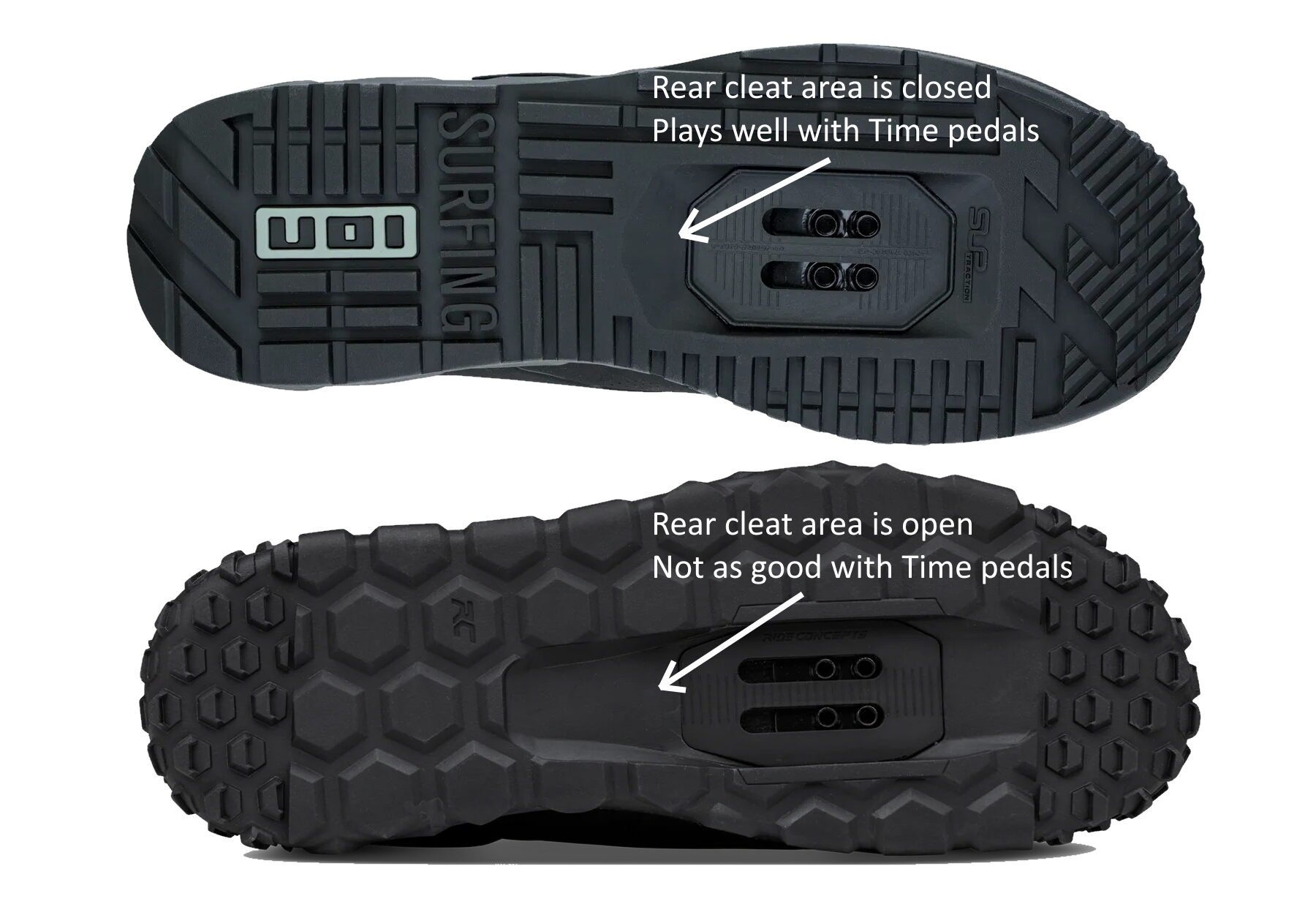
Pick a Pedal and be a Dick About It
Noah: I’ve laid out my case for why I ride Times, but given that there are only four (even remotely) mainstream brands of clipless pedals on the market, the question could also be posed as: why Times instead of some other brand? So here is my somewhat subjective take on each pedal type’s strengths and weaknesses, as well as David’s perspective.
Shimano Pedals:
Noah: Shimano makes a great pedal. They’re durable, they’re about as slim and low profile as you can get in a clipless pedal, they work incredibly well, and they last approximately forever. They’re also easy to come by and reasonably priced, which is always a bonus.
Personally, I don’t run Shimanos because I’ve found they don’t hold my feet in well enough. Their spring tension is adjustable, but even at max tension, the release is still relatively light. Shimano offers a few different cleat options, but their standard cleats offer 4° of float and a 13° release angle. I have some not particularly fond memories of using Shimano pedals, hitting a hipped jump, unclipping both feet mid-air, and with both legs flailing, riding the top tube into a bush. I switched to Times shortly thereafter and haven’t looked back.
David: Yup. I was an SPD rider for a long time but moved away from them for the exact same reason as Noah. Even with the release tension maxed out, I’d periodically inadvertently unclip my outside foot on a hipped jump or when swinging my hips out through a corner. Bad things tended to ensue from there.
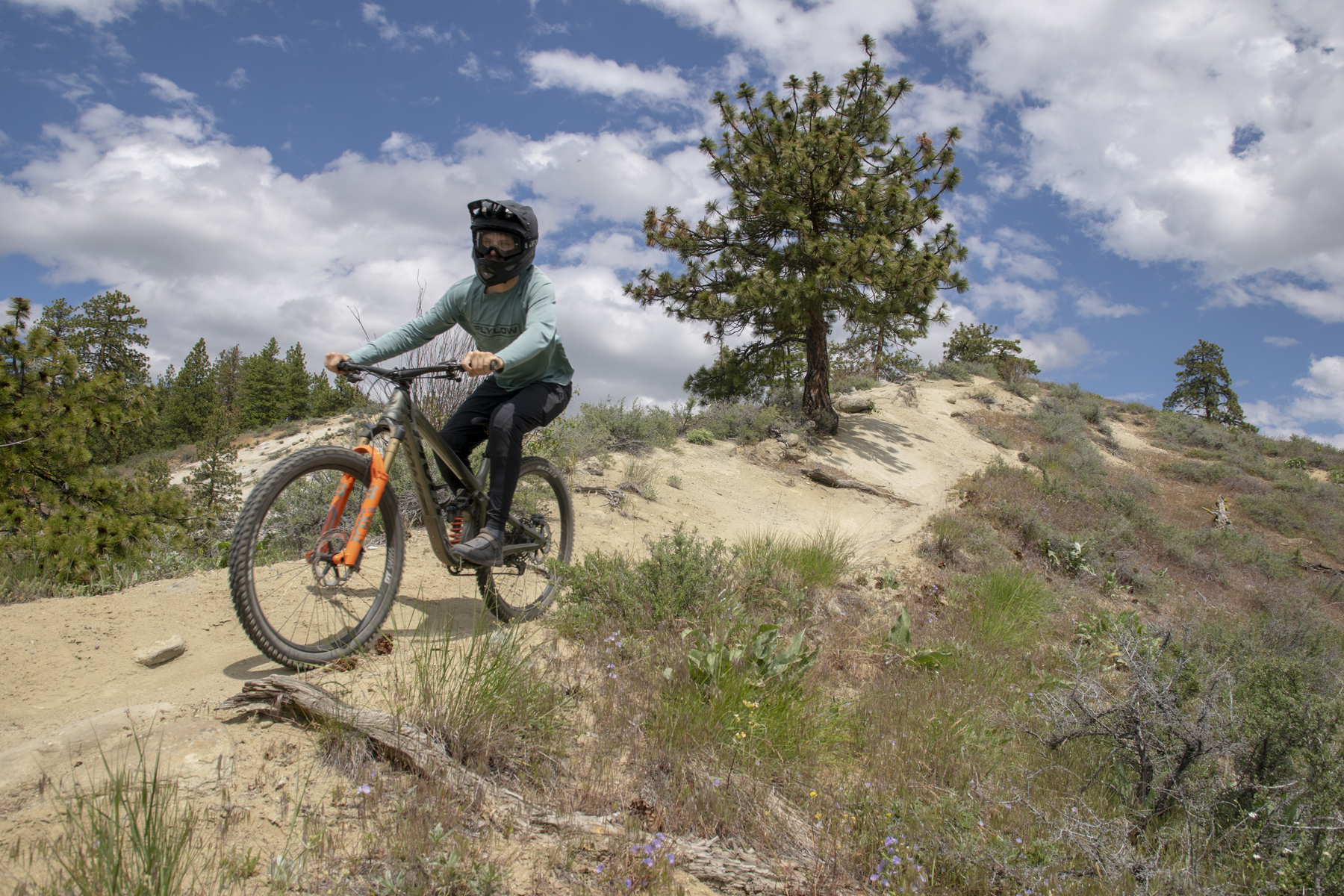
Shimano’s pedals are well built and durable (even the relatively affordable ones), their cleats last a long time and are available everywhere, and I’m a fan of their relatively thin platform (especially on the higher-end variants, such as XTR Trails). But I want more release tension than they offer.
Crankbrothers Pedals:
Noah: On paper, Crankbrothers offers a fantastic pedal. Crankbrothers has done a really good job of making the pedals modular so they can be adjusted with shims (both on the pedal and on the shoe) to optimize the pedal-to-shoe interface. It makes it far easier to dial in how the shoe feels on the pedal than any other pedal system. Crankbrothers also offers two different axle lengths, so you can dial in your Q factor.
Spring tension isn’t adjustable on Crankbrothers, but they do offer cleats with release angles of 10° or 15°, and float of either 0° or 6°. Once I’m clipped into them, I really like how Crankbrothers ride — they have enough float and a high enough release angle to keep me happy, and the pedal-to-shoe interface is excellent.
My issue with Crankbrothers pedals is four-fold. First, I can’t clip into them consistently and efficiently. The bails in the middle of the pedal are detached from the cage around them, which means the bails and the cage can spin independently. This means the bails are (potentially) in a slightly different place every time I go to clip in. With any other clipless pedal, I pretty quickly get used to where I need to jam my foot into the pedal to get clipped in. After a year on Crankbrothers pedals, I still couldn’t quickly get my foot in consistently.
Second, the spring tension is relatively low on Crankbrothers, and it’s not adjustable. I find both the entry and exit from the pedal to sometimes feel a bit vague and lacking the clear *click* that you get with Times and Shimanos. Third, the Crankbrothers bails will open and eject your foot if they hit the ground. This is annoying. And finally, Crankbrothers have a well-earned reputation for not being particularly durable. They’ve gotten better over the years, but they’re still in last place on the durability front.
David: The only part of Noah’s take that I disagree with is the bit about liking the way Crankbrothers pedals feel when clipped in, for reasons that I’ll outline in a moment. Their build quality has gotten a lot better in recent years, so their previously well-earned reputation for breaking in myriad and novel ways isn’t particularly true of their newer offerings. However, the combination of the moving bails making clipping in unpredictable, and their propensity for releasing when struck from below, are both major downsides in my book.
I do think that Time pedals are a good option for folks who like the feel of Crankbrothers pedals but are put off them for either of the reasons we’ve outlined above. The feel of Time pedals, once clipped in, is more similar to Crankbrothers than it is to any other option here, but I’ve found Times to be more predictable and consistent, both in how they feel to clip in and in not having a surprise eject button built into the bottom side of the pedal.

As Noah noted, though, I do really like Crankbrothers’ system for dialing in the pedal-to-shoe interface with shims on both the pedal body (of certain models) and under the cleat. On the Time Speciale 10 — even with the Large platform — I felt like there was an appreciable lateral rocking sensation as the sole of the shoe tipped side to side a bit before making contact with the pedal body. (I tried Crankbrothers Mallet Boa and Specialized 2FO DH shoes with similar results.)
HT Pedals:
David: I wound up converting to HT pedals after getting tired of twisting myself out of SPDs at inconvenient moments, and while they’re not perfect, they’re my preferred pedal system overall. The biggest reason I’m into HT’s design is that they’re the most locked-down feeling clipless pedal I’ve found to date, both in terms of offering very high release tension if you want it (the SX versions especially) but, more importantly for my preferences, in that they can be set up to have a very solid connection to the pedal body and very little float.
That’s all very much in the personal preference area — I’m not going to argue for a second that it’s objectively better, but it is what I like. You can check out our review of the HT T2 and X3 for a lot more on their design and construction. But with their lower-float cleat option, HT’s pedals offer the most direct-feeling connection to the bike that I’ve experienced in a clipless pedal to date. There’s still some float (nominally 4°), but the HT pedal mechanism feels like there’s some springiness / resistance through that float range, and the release angle is fairly shallow. So, in contrast to the Time approach of keeping you in the pedal by offering (depending on your cleat setting) a notably wide release angle, HT’s pedals excel at offering a super secure-feeling connection to the pedal with little float and an especially stiff release if you want it.
(For the record, I run the standard HT pedals at about ⅔ of their maximum tension, and the SX versions at about ¼. Again, check out our Full Review of the HT T2 and X3 for more on those pedal variants.)
I’m also a fan of how thin HT’s pedals are (the X3s especially), at just 14.3 mm thick at the center of the pedal body. A couple millimeters of difference there might not sound like much, but it’s surprising how quickly a little added thickness can make a pedal feel tall and tip-y, especially after you’ve gotten used to something thinner.
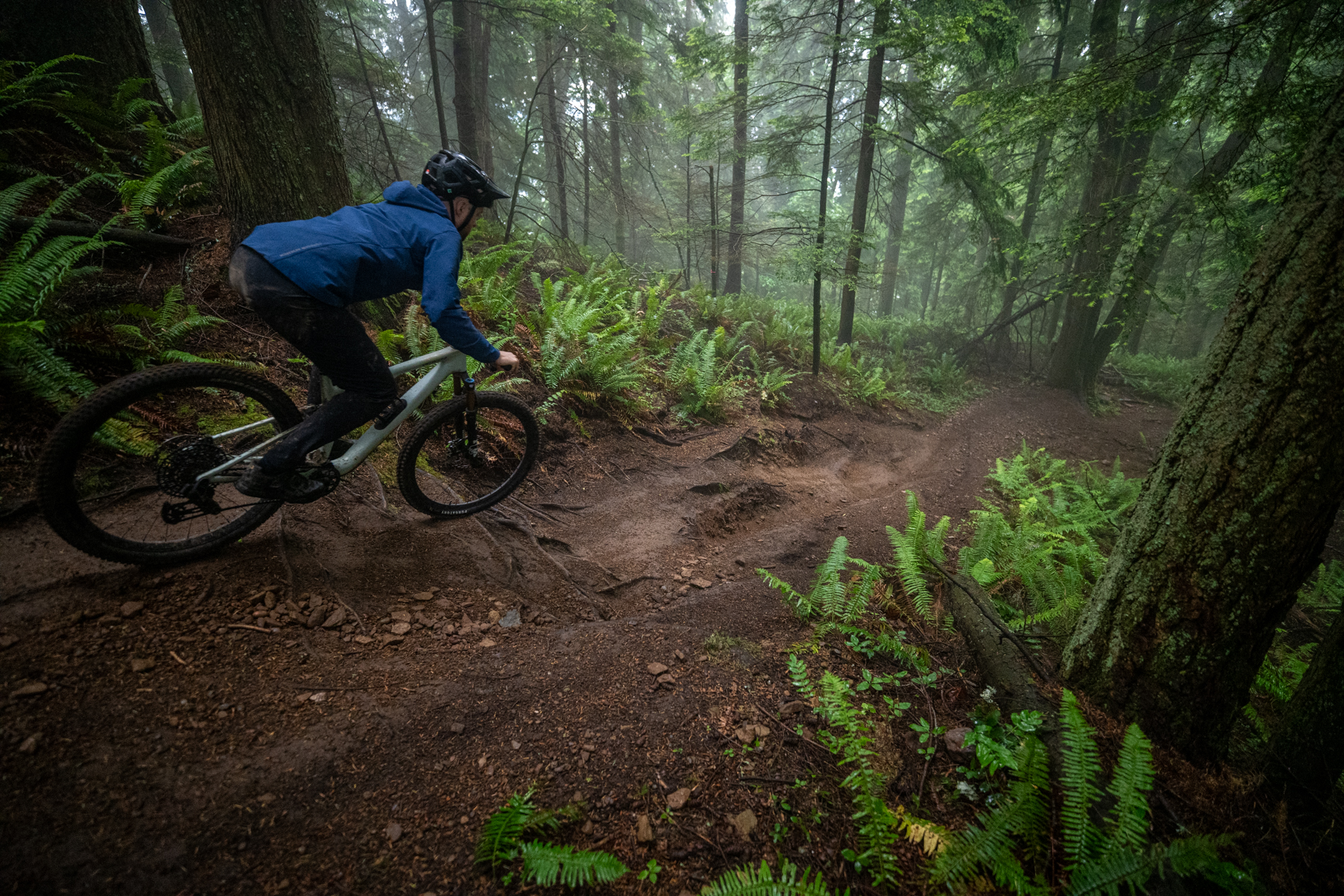
I have found HT’s spindles to be not all that well sealed, and they require some periodic maintenance to keep things running smoothly. However, it’s not that hard to do, and rebuild kits are cheap. The X3 body can also interfere a little with certain shoes, especially those with notably curved / rockered soles, but I’ve been able to make most shoes work well with a little cleat shimming.
Especially at the higher end of their tension settings, HT’s pedals do take a bit more force to clip into and out of than Time or Crankbrothers pedals, and HT pedals aren’t quite as smooth feeling in their unclipping motion as SPDs. Still, I’m fine with that tradeoff for their excellent retention and relatively locked-down, un-float-y feel.
Flat Pedals:
Noah: Flat pedals have plenty of upsides, and people who ride flat pedals are never shy about making sure everyone knows that. Personally, I like clips because my foot is always in the exact same spot on the pedal, which makes it easier for me to make the bike do what I want. I also like being locked in — it doesn’t matter how rough the trail is or what I’m doing on the bike, my foot isn’t going anywhere. But there are certainly times (usually on a trail with lots of skinnies, or when things are epically wet and slick) when I get a yearning for the old days when I mostly rode flats. Oh, and of course, flat pedals win medals (or so I’ve been told, ad nauseam).
David: I ride flats from time to time, both because the occasional change of pace is fun, and because I find that being able to do it well is a useful skill-building exercise that carries over to being clipped in, too. I’m faster in most situations — up and down — when clipped in, but the cornering feel of flats and the direct, slop-free connection that they offer can’t be matched, and there’s more to life than just being fast.
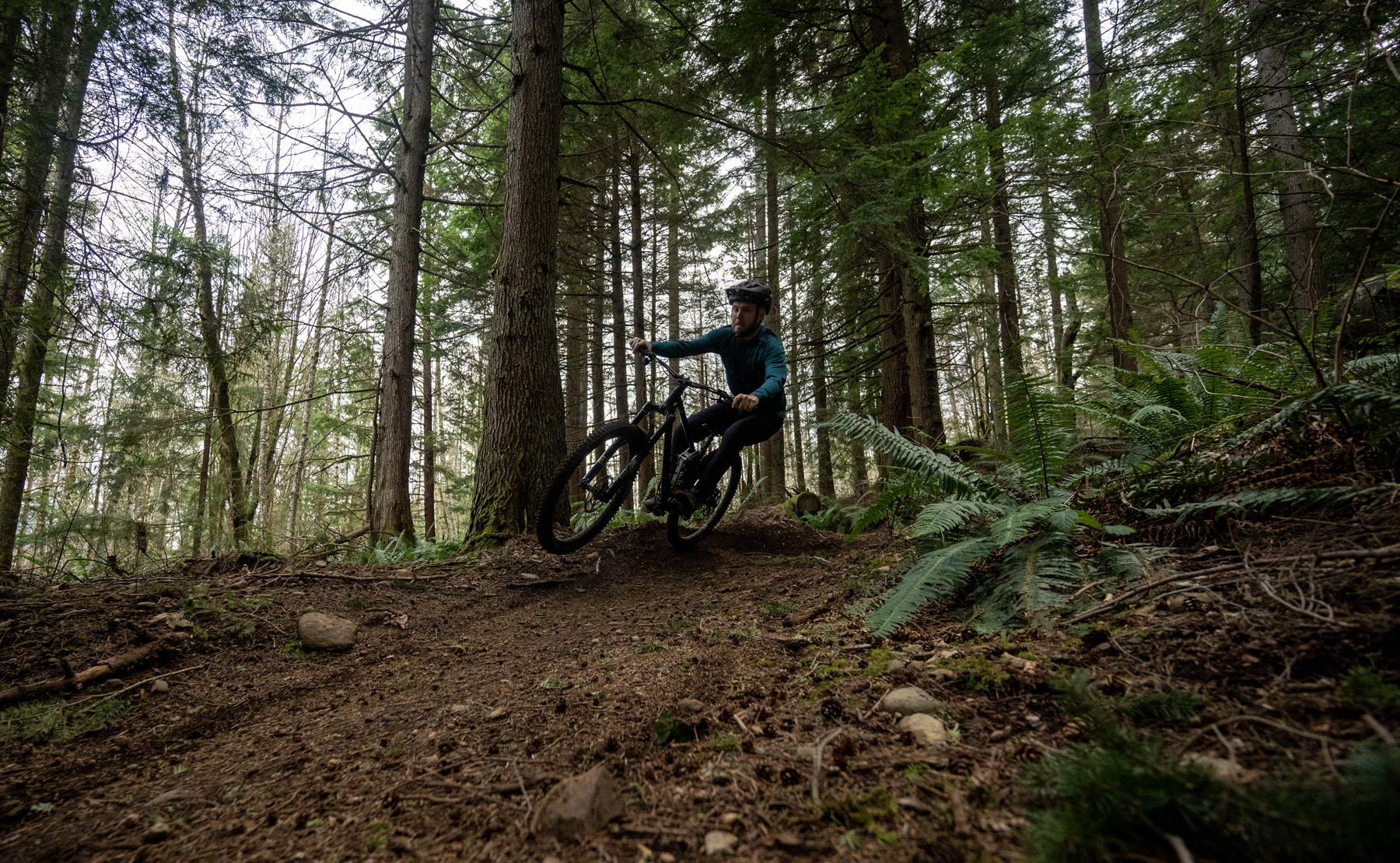
Bottom Line
With the new Speciale 10 and 12, SRAM hasn’t messed with what made Time pedals a popular option in the first place. And they lightly reshuffled the lineup and added some options for different platform sizes while they were at it. So, longtime fans can rest easy — the ATAC mechanism and overall feel haven’t really changed.
But for folks who aren’t already converts, the new Speciale pedals are a good option if you prioritize ease of clipping in and out, especially if you want to pair that with slightly stronger retention than Crankbrothers’ pedals offer. And while we’ve only been on the new Speciales for about two months, their predecessors have a great track record durability-wise, and there’s nothing about the design that would lead us to expect anything different from the new ones.
We’ll report back if any notable issues crop up, but all indications are that the new Speciales have mostly taken an “if it ain’t broke, don’t fix it” approach, and we’re certainly not complaining.

Really great review, guys. I started with Time pedals over 20 years ago and then switched to Crank Brothers around the time Egg Beaters hit the market, using them ever since. I finally got so fed up with their durability and, in particular, the super-aggravating rebuild kits (where Crank Brothers’ own YouTube installation video misses a step in certain situations) that I walked away, despite still preferring their feel over everything else.
I snagged several Time pedals on closeout and installed them on my two MTBs where I clip in. Everything seems to be going well, but I use a pair of Specialized MTB shoes (Recon 3.0), and I’ve been getting this annoying squeak almost the entire time. I have the Speciales and also the MX models. Amazingly, both of them make the same squeaking sound. I’m certain it’s the pedals. If I ride with street shoes (i.e., not clipped in), no squeak. I’ve noticed that if I run my feet through wet grass, the squeak goes away for a while.
Does anybody have a solution? I’ve thought about spraying them with a lube, but that’s likely to result in a big mess, even though it might temporarily solve the issue.
Try a small drop of lube at the bottom of the bails (where they’re coiled around the shaft they’re attached to). I do each corner of the bails, on both sides of the pedal with something light like tri-flow. *Usually* takes care of any squeaking.
I find I need to periodically add some lightweight lube like tri flo to keep squeaking at bay.